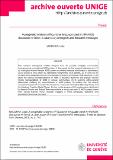| dc.description.abstract | This research investigates whether Kenyans from 42 mutually intelligible communities homogeneously comprehend AIDS posters. In this regard, the five research objectives are: (1) to investigate whether Kenyan AIDS posters are skewed towards implicitness or explicitness, (2) to access to what extent do addressees comprehend AIDS posters, (3) to carry out an in-depth lexico-pragmatic analysis of processes involved in the Kenyan AIDS discourse, (4) to study the various conceptualizations of AIDS in figurative discourse and analyze Kenyan mental representations of AIDS in various communities, (5) to examine ethno-cultural stereotypes inhibiting the implementation of AIDS posters. To achieve this, the study's conceptual framework comprises the Relevance Theory, the Conceptual Blending Theory and the Idealized Cognitive Model Theory. Further, in the analysis of 61 questionnaires distributed to Maseno Division and Eldoret Town respondents in Kenya, and also 21 AIDS posters drawn from various Kenyan NGOs websites engaged in AIDS campaigns, qualitative and quantitative techniques are used. | en_US |

